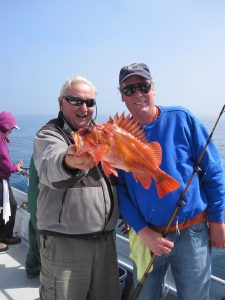Duxbury Reef Surveys (2005 - 2008)
Download the Duxbury Reef Final Report.
In 2005 and 2006, we conducted a collaborative research study in the heavily fished area off Bolinas, California to gather information about species targeted in commercial and recreational fisheries. Our goal in this project was to combine the resources of fishermen and university scientists to learn more about populations of nearshore fishes and provide information that will be useful for policy discussions regarding marine protected areas (MPAs) in the region. We worked with charter boat skippers and more than 200 anglers to catch, measure, tag, and release fishes to gain information about the distribution, abundance, and movements of recreationally targeted species.
 Over 5,500 fish were tagged and released over the course of 31 sea days in 2005. In 2006, we allocated 8 sea days to fishing in the same fishing locations and depths in 2005, as well as in deeper water habitats. In areas where fishing effort overlapped and depth range was similar between years, we found a significant difference in species composition. However, these data are difficult to interpret because the sample sizes were greatly different in each year. In 2007, we plan to fish in these locations again to increase our sample size and continue to look at interannual variation in species composition.
Over 5,500 fish were tagged and released over the course of 31 sea days in 2005. In 2006, we allocated 8 sea days to fishing in the same fishing locations and depths in 2005, as well as in deeper water habitats. In areas where fishing effort overlapped and depth range was similar between years, we found a significant difference in species composition. However, these data are difficult to interpret because the sample sizes were greatly different in each year. In 2007, we plan to fish in these locations again to increase our sample size and continue to look at interannual variation in species composition.
Tag-recapture data were recovered from fish caught in the recreational and commercial fisheries. When fishermen recaptured a tagged fish, they would notify us with the tag number and coordinates of recapture. 80% of recaptured fishes moved less than 1 nm from their release location, and 95% were caught within 5 nm of release location. This provides good evidence that the majority of species we caught have relatively small home ranges. There were some notable exceptions, however, to this pattern of relatively localized movements. Our data indicate that there may be some interchange between the populations of black and yellowtail rockfishes at Duxbury Reef area and those at the Farallon Islands. There were also four black rockfish caught over 300 nm away; these fish may have been advected northward by northerly currents caused by the frequent and strong storms we experienced in the winter of 2005-2006.
We also collected length and maturity data from the fish we sampled. The mean lengths of almost all species were below the corresponding lengths at 50% maturity for their species. (Maturity is defined as the size at which 50% of the fish at that size are mature). These data indicate much of the catch in the study area was comprised of individuals that are immature. The mean lengths of most species that were caught in this study, however, have not significantly changed since about 1995, a pattern similar to that generated from CPFV fisheries in other areas in Central California. These observations indicate that the current population size and age structures of fished species may be in equilibrium with the current rate of fishing, and that almost all fish are caught before they reach the size at 50% maturity. Additional research is necessary to determine whether the whether or not the current level of fishing is appropriate to maintain the population size and age structure of a species in a long-term sustainable manner.
This project proved to be a successful collaborative research endeavor involving commercial passenger fishing vessels, recreational anglers, and university scientists. All people involved contributed greatly to the collection of scientific information, and information was shared among participants and to a broader audience via web-based communications. Based on the high catch rates experienced in this study, and that have continued over the past few decades, we believe the Bolinas Bight is a productive location for nearshore rockfishes. We plan to continue our work to collect more data on changes on interannual species composition and further investigate some of our hypotheses about the age and size structure of these populations.
Participants: Kristen Green (MLML), Dr. Rick Starr (MLML), Roger Thomas and many volunteer anglers
Funding Provided By: Pacific States Marine Fisheries Commission (PSMFC)

